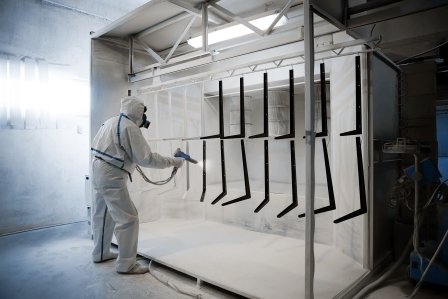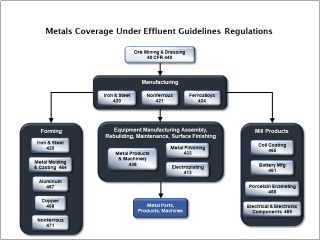Porcelain Enameling Effluent Guidelines

The EPA promulgated the Porcelain Enameling Effluent Guidelines and Standards (40 CFR Part 466) in 1982 and amended the regulation in 1985. The regulation covers direct and indirect dischargers. The Effluent Guidelines and Standards are incorporated into NPDES permits for direct dischargersA point source that discharges pollutants to waters of the United States, such as streams, lakes, or oceans., and permits or other control mechanisms for indirect dischargersA facility that discharges pollutants to a publicly owned treatment works (municipal sewage treatment plant). (see Pretreatment Program).
On this page:
- What is the Porcelain Enameling Industry?
- Facilities Covered
- Related Categories
- Rulemaking History
- Additional Information
What is the Porcelain Enameling Industry?
Porcelain enameling is the application of glass-like coatings to metals such as steel, cast iron, aluminum, or copper. The purpose of the coating is to improve resistance to chemicals, abrasion, and water and to improve thermal stability, electrical resistance, and appearance. The coating applied to the workpiece is a water-based slurry called a "slip" and is composed of one of many combinations of frit (glassy-like material), clays, coloring oxides, water, and special additives, such as suspending agents. These vitreous inorganic coatings are applied to the metal by a variety of methods such as spraying, dipping, and flow coating, and are bonded to the base metal at temperatures in excess of 500 °C (over 1000 °F). At these temperatures, finely ground enamel frit particles fuse and flow together to form the permanently bonded, hard porcelain coating.
At the time of the 1982 rulemaking there were approximately 130 porcelain enameling facilities in the United States.
- 332439: Other Metal Container Manufacturing
- 332812: Metal Coating, Engraving (except Jewelry and Silverware), and Allied Services to Manufacturers
- 332998: Enameled Iron and Metal Sanitary Ware Manufacturing
- 335221: Household Cooking Appliance Manufacturing
- 335222: Household Refrigerator and Home Freezer Manufacturing
- 335224: Household Laundry Equipment Manufacturing
- 335228: Other Major Household Appliance Manufacturing
Note: The NAICS listing is provided as a guide and does not define the coverage of the Porcelain Enameling category. For precise definitions of coverage, see the Applicability sections in 40 CFR Part 466.
Manufacturing Techniques and Wastestreams
There are two major groups of standard process steps used in manufacturing porcelain enameled materials:
- Surface preparation is for removal of soil, oil, corrosion, and similar dirt from the basis material. The clean surface allows the porcelain enamel to bond well with the basis material
- Coating, including ball milling and enamel application. Ball milling is performed to mix and grind frit and other raw materials, forming an enamel slip of appropriate consistency for a particular application.
Water Use
The cleaning processes for removing oil and dirt employ water based alkaline cleaners. Acid pickling solutions are used to remove oxides and corrosion and to etch the surface of the workpiece. Water is also used to rinse the basis material after it has been cleaned by the above listed processes.
A water solution of nickel salts is used in nickel flash operations in the steel subcategory.
The ball milling operation uses water for washing out the ball mills between mixing batches and for cooling the ball mills. During application of the porcelain enamel slip, water may be used as a curtain device for entrapping waste slip from overspray.
The characteristics of the wastewater generated by a porcelain enameling facility may vary depending on basis material cleaning and coating.
Significant Pollutants
- Toxic metal pollutants: antimony, arsenic, cadmium, chromium, copper, lead, nickel, selenium, and zinc
- Conventional pollutants: suspended solids, pH (abnormally high or low), and oil & grease
- Unconventional pollutants: aluminum, cobalt, fluoride, iron, manganese, phosphorus, and titanium.
Because of the amount of toxic metals present, the sludges generated during wastewater treatment generally contain substantial amounts of toxic metals.
Facilities Covered
- Steel Basis Material (Subpart A)
- Cast Iron Basis Material (Subpart B)
- Aluminum Basis Material (Subpart C)
- Copper Basis Material (Subpart D)
The regulation does not apply to porcelain enameling on precious metals.
Related Categories
Rulemaking History
1985 Amendment
- Final Rule (September 6, 1985)
1982 Initial Rulemaking
- Documents, including:
- Final Rule (November 24, 1982)
- Development Document (November 1982)
Industry description, wastewater characterization, treatment technologies, regulatory compliance cost estimates and pollutant loadings for the final rule - Proposed Rule (January 27, 1981)
Additional Information
For additional information regarding the Porcelain Enameling Effluent Guidelines, please contact Anthony Tripp (tripp.anthony@epa.gov) or 202-566-1419.

